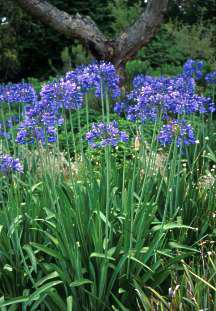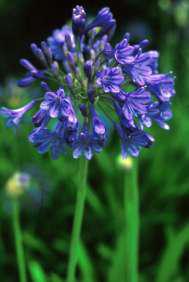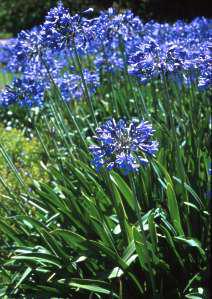Agapanthus caulescens
Agapanthus caulescens Leighton
Family: Agapanthaceae
Common names: stem agapanthus
Introduction
This is one of the most beautiful species in the agapanthus family, but is virtually unknown as a garden plant as it is seldom available from nurseries.

Description
Description
The plants are deciduous and occur in summer rainfall areas where the temperature sometimes drops below zero degrees Celsius in winter and where it may snow. In the winter rainfall region of South Africa plants go dormant and are unaffected by the winter rains if they have a well drained site.
There are three subspecies of Agapanthus caulescens:
- A. caulescens subsp. caulescens, which has the largest flowers and the broadest leaves (40 mm in width or more).
- A. caulescens subsp. angustifolius has smaller flowers and narrower leaves, which are erect or semi-erect.
- A. caulescens subsp. gracilis also has smaller flowers but the perianth segments are markedly recurved. The leaves are also narrower but more lax in habit. Agapanthus nutans is now considered to be synonymous with A. caulescens subsp. gracilis and the species name A. nutans is obsolete (B.J.M. Zonneveld and G.D. Duncan 2003).
All three subspecies of Agapanthus caulescens flower in mid summer in South Africa, the flower colour ranges from dark to light blue. A white form of A. caulescens subsp.caulescens exists.

Distribution and habitat
Distribution description
Agapanthus caulescens subsp. caulescens occurs in Swaziland. A. caulescens subsp. angustifolius occurs in Swaziland and Kwazulu/Natal as well as in Mpumalanga, while A. caulescens subsp. gracilis occurs in Kwazulu/Natal and in the Limpopo Province. All plants are found in grassland in the open, often between rocks and boulders. They all occur in the summer rainfall areas and die down in winter.

Derivation of name and historical aspects
History
Agapanthus was first described in 1679 and the genus was named by L'Heritier in 1788. The name is derived from the Greek agape which means 'love' and 'anthos' referring to the flower. A. caulescens was first described in 1901 by Sprenger, who grew plants from seed sent to him by a friend who had collected the seed in the mountains of Mpumalanga. Descendents of these plants are believed to grow in Kew and Glasnevin.

Ecology
Ecology
Agapanthus flowers are pollinated by birds and insects. Seed is dispersed by the wind. Although the seed is usually prolifically produced, it may be heavily parasitized by a host of insects. Despite this the percentage of seed germination is usually high.

Uses
Use
Plants are used mainly in large groups as landscape subjects in Kirstenbosch National Botanic Garden. Agapanthus caulescens is little known outside botanic gardens and yet it is a splendid free flowering plant with flowers ranging in colour from dark to light blue. They also make good container plants and are excellent and long lasting cut flowers. All agapanthus flowers which are dark blue/purple will fade in colour when placed indoors.
Cultural uses are well described in articles on other agapanthus plants (see A. praecox).
Growing Agapanthus caulescens
Grow
Plants of Agapanthus caulescens are easy to grow and can readily be split to increase the stock. The best time to divide A. caulescens is in spring, just as the plants start to sprout new leaves. Plants can also be split during the growing season but never during winter.
Agapanthus cross freely and if any other agapanthus plants are growing nearby, the seed which sets will be hybridised. Seed sown in a well-drained seed mixture and lightly covered will germinate readily within two to four weeks. Never let seed trays dry out and only sow when temperatures are above 18 degrees Celsius.
Seedling and adult plants respond well to composted soil and an application of a slow release fertiliser. Plants grown from seed will flower in their third year after sowing. Generally plants are pest free and will outgrow most problems. Snout beetles can cause damage and remedies for these pests can be found in most nurseries.
References
- Leighton, Frances M. 1965. The Genus Agapanthus L'Heritier. Journal of South African Botany, Supplementary Volume No. IV.
- Duncan, G. 2002. Grow Agapanthus. Kirstenbosch Gardening Series, National Botanical Institute, Cape Town.
- Zonneveld, B.J.M. and Duncan, G.D. 2003. Taxonomic implications of genome size and pollen colour and vitality for species of Agapanthus L'Heritier (Agapanthaceae). Plant Syst. Evol. 241: 115-123 (2003).
Credits
Richard Jamieson
Kirstenbosch Garden Centre
December 2004
Plant Attributes:
Plant Type: Bulb
SA Distribution: KwaZulu-Natal, Mpumalanga
Soil type: Loam
Flowering season: Late Summer
PH: Acid, Neutral
Flower colour: Blue
Aspect: Full Sun
Gardening skill: Average
Special Features:
Horticultural zones










Rate this article
Article well written and informative
Rate this plant
Is this an interesting plant?
Login to add your Comment
Back to topNot registered yet? Click here to register.